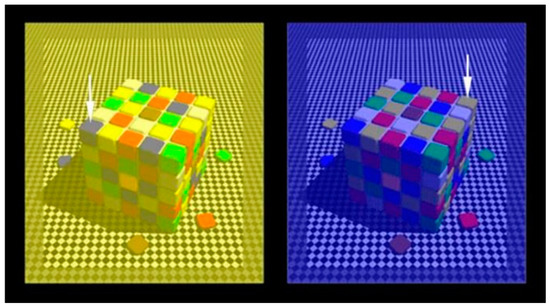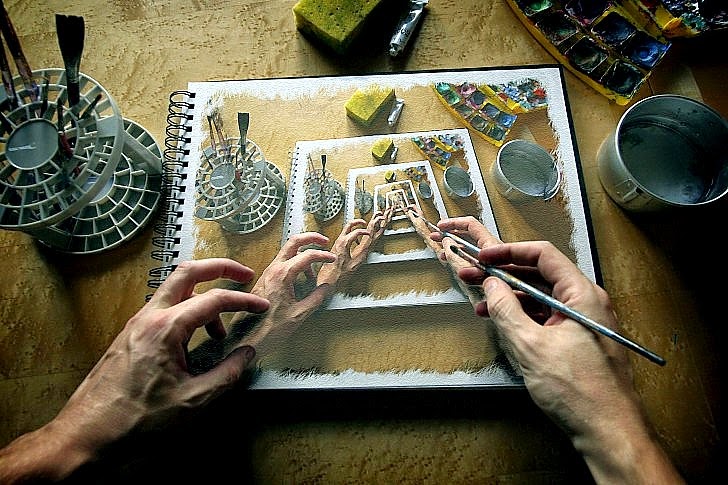Cleric K wrote: ↑Fri Jan 05, 2024 2:45 pm
Great, this makes it much clearer.
In a proper phenomenological approach this is all that we can safely say: We exercise our spiritual activity and we recognize that certain phenomena/qualia manifest or disappear from our field of consciousness.
As you can see, in both your and my model one can’t go behind qualia. Now we have settled that ‘creation’ of a quale doesn’t refer to how its experiential essence is 'built up’ from something else, but to what we need to do with our spiritual activity in order for it to appear/disappear.
There is still a difference. And that is that qualia being meaning they are not random. They might not "appear/disappear", but their existence is not random, but is structured according to the inclusion and transcendence of meanings of self-reference (colors contain shades-of-gray which contain black-and-white which contains vividness which contains the Self, etc.)
Cleric K wrote: ↑Fri Jan 05, 2024 2:45 pm
Let’s say we’re drawing a triangle. Then we decide to be self-aware and try to make a new picture of ourselves drawing the triangle. We want to include ourselves in the picture, not only the triangle. But the moment this picture takes shape it is already obsolete. It no longer represents reality because now the new reality is that we’re drawing a picture of “ourselves drawing a triangle.” We can try to draw that too but the same situation repeats. In a way, when we try to introspect our own thinking activity, the image is always one step in the past compared to our present invisible activity, which draws the image but is not yet itself included in it.
Would you agree that in this intimate experience of thinking, where we continually try to picture our activity like the hands drawing hands, we have the most intimate example of the
real self-reference that you describe? And then, would you agree that by building complicated pictures within pictures we only accumulate abstractions of the self-reference, while we completely forget about the real activity that thinks the images?
This is precisely the example that I gave in some of the papers, first time in "The Self-Referential Aspect of Consciousness". And I quote from that paper:
--------------------------------------------------------------------------------------
"The unformalizability of self-reference
Because no formalization of self-reference is possible, is better to start with this aspect in order to avoid chasing impossible goals. Let’s see what is self-reference in the vaguest sense and why it is unformalizable. A classic example where self-reference is mentioned is as follow: You first look at a unicorn. Then, you reflect on you looking at the unicorn. This is a trivial and easy to understand example. Fortunately, in order to show the unformalizability of self-reference we don’t need any more complicated examples. Let’s see thus why self-reference cannot be formalized. Let’s say that you want to capture somehow the fact that you are seeing a unicorn. This seems simple. You just take a paper, and you write: “I see a unicorn.”. This is what a formalization of consciousness is supposed to look like and it seems that you just did it. But on a careful second look, you notice that by writing down that sentence, you just took yourself outside of the very quale that you wanted to capture.
Now, instead of being in the state that you wanted to capture, you find yourself in another state, namely: “I write on the paper that I see a unicorn.” So, all of a sudden, you realize that what you thought that was a successful attempt at formalizing consciousness, just slipped through your fingers. One thing that you can do at this moment, is to try again to capture consciousness. So, you take another piece of paper and you write the new state in which you find yourself: “I write on the paper that I see a unicorn.”. But by doing this, you again exited the very state that you tried to capture, and you ended up in the new state: “I write on paper that I write on paper that I see a unicorn.”. Thus, the next realization that you come up to is that no matter how many times you try to capture your current state, the very act of trying to capture that state will take you out of that state. So, you start to envision the possibility that maybe there is something about consciousness that will forever escape formalization.
Having seen this first example of how consciousness escapes formalization, we can try to pin down more exactly what is the actual reason for consciousness escaping formalization. This reason is the nature of self-reference. Let’s see exactly how this works. First thing to mention, is
that, of course, formalization doesn’t require writing on a piece of paper. It suffices if it is all done in one’s own mind. So, if we want to formalize the act of seeing a unicorn, we need to reflect back on the state of seeing the unicorn, so we need to form the state: “I know that I see a unicorn”. But this has the above mentioned effect of taking us out of the very state that we want to capture. So, let’s write more precisely the two states that we are dealing with.
The first state is: “I am in the state “I see a unicorn”.”
The second state is: “I am in the state that I know that I am in the state “I see a unicorn”.”
So, what we see here is actually an “I” that by trying to capture its current state, it finds itself in another state. The way the “I” is trying to capture its current state, is by reflecting on that state. But since that state is part of itself, the “I” is reflecting on itself, so it is self-reflecting. And here we identify the true reason that consciousness escapes formalization: The act of self-reflection takes the “I”/Self out of that state, so it makes impossible to capture it in a formal manner. This act of self-reflection is what we take a first vague meaning of self-reference to be. Thus, we have our first clue that self-reference is unformalizable. For every “I am X” state in which the Self finds itself, there is always another “I am “I am X”” state that the Self is pushed into, if it tries to formalize the state “I am X”. And the reason is simple: in order to formalize the current “I am X” state, the Self must think about it, but by thinking about it, it becomes that new thought, so it takes the new form “I am “I am X””, which replaces the very state that the Self wanted to formalize.
This is only just the first and easiest example where we spot the unformalizability of self-reference. Throughout the paper, by following along the emergent structure of consciousness, we will spot many other ways in which the unformalizability of self-reference will pop up. Those cases will become more difficult and an increased attention will be required in order to appreciate their true significance.
A note to make here is that even though it might appear that unformalizability represents a dead end in any attempt to gain more knowledge about consciousness, it will be shown that we can actually gain more knowledge about consciousness if we accept this fact. It will be shown that the entire emergent structuring of consciousness is possible precisely because self-reference is unformalizable."
--------------------------------------------------------------------------------------
But precisely because of this impossibility of capturing self-reference, we deduce that is something quite special, namely not an object, but an interplay between form and formless. Even though we cannot understand it, this doesn't forbid us from understanding why we cannot understand it. Scott Roberts from this group also talked about this thing in his Tetralemmic Polarity about form and formless:
https://sites.google.com/site/nondualis ... c-polarity
And I quote from him:
"The first observation to make is that there is no denying that tetralemmic polarity cannot be understood, in the usual meaning of the term "understand". But the reason it cannot be understood can be understood, and that is that one pole of the polarity -- formlessness -- is not an object. When we say we understand X, X must be an object. Hence we should not expect that the act of understanding, which is a kind of thinking, can understand itself, much as "seeing" cannot see itself. But we can, so to speak, get used to tetralemmic polarity. It is the stance from which everything else can be understood."

